February 2024
1. Headline indicators
Employment in December was up by 38,200 on the previous month and up by 72,200 on the July-September 2023 quarter, to 31,174,000. The employment rate for those aged 16-64 went up slightly to 75.0%, from 74.8% in the last quarter.
Economic inactivity for those aged 16-64 went up by 23,600 on the previous quarter to 9.28 million. The economic inactivity rate remained the same at 21.9%.
Unemployment for those aged 16-64 fell by 81,200 compared with the previous quarter to 1.3 million. The unemployment rate fell to 3.9% from 4.2% in the previous quarter.

2. Nominal pay rises continue to outstrip inflation, but are starting to fall
The latest data show average regular earnings grew by 6.2% in the year to December 2023, down from 6.7% in November 2023 and the post-pandemic peak of 7.9% in August 2023. For public sector workers average regular earnings grew by 5.8% in the year to December 2023, while average regular earnings grew by 6.2% for private sector workers. After taking account of inflation, real regular earnings went up by 1.8% (3-month average change) in the year to December 2023, with the single month data for December showing a real-terms increase of 1.9% over the year.
The rate of inflation has been falling since May 2023, but CPIH remained static at 4.2% in November and December. In the year to December 2023 core CPIH (excluding energy, food, alcohol and tobacco) rose by 5.2%, the same as the increase seen in the year to November 2023. Inflation in areas like Food and non-alcoholic beverages, Health, Communication and Restaurants and hotels is still very high and inflation in the UK remains above that in other countries in the G7. The United States is currently experiencing an inflation rate of 3.4% while the Eurozone average is 2.9%. Weak growth since the global financial crisis means average earnings are around £12,000 per year lower than if pre-crisis trends had continued.
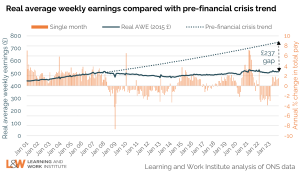
3. There are fewer potential workers for employers to recruit, with 901,000 fewer over 50s in the labour market since the pandemic started
Recruitment has been more challenging for employers since the pandemic because of rises in economic inactivity – people leaving the labour market. The number of people aged 50 to 64 who are economically inactive has increased by 8.1% since the pandemic started.
Economic inactivity has been fairly static since the Summer of 2023, with the rate standing at 21.9% for those aged 16-64 in October to December 2023 – the same rate as in the July to September quarter. Overall the number of those aged 16 to 64 who are economic inactive is 728,000 higher than pre-pandemic, yet only one in ten out-of-work older people and people with a disability get employment support each year. The Government needs to extend employment support to more people outside the labour market and employers need to think about recruitment and job design to attract and retain staff.
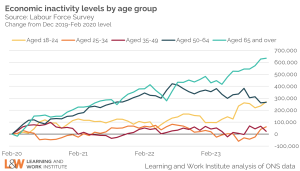
4. Quarterly data for employment across ethnic groups and for those with a disability show substantial differences remain between groups
In the October to December quarter of 2023 the employment rate for people from a Bangladeshi, Pakistani or Chinese background or Mixed/multiple ethnic groups was higher than in the same quarter in 2022. Those from Indian backgrounds and those who consider themselves to be Black/ African/ Caribbean/ Black British, White or from another background were less likely to be employed in the final quarter of 2022 compared with one year earlier. Some of the volatility in employment rates from quarter to quarter is due to the fact that the series is not seasonally adjusted.
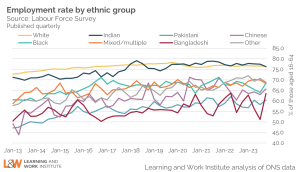
The latest disability employment data shows that the unemployment rate for people with disabilities has generally been on a downward trajectory over time. In the October to December quarter of 2023 it stood at 5.6%, a fall of 1.7 percentage points compared with the same quarter one year earlier.
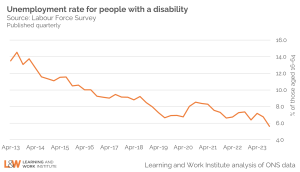
5. Over one million young people are not in employment or full-time education
The unemployment rate for young people aged 16-24 in the October to December quarter of 2023 was 11.6%, almost identical to the rate in the same quarter one year earlier (11.5 per cent). The number of young people aged 16-24 not in employment or full-time education currently stands at 1,047,000. Whilst the percentage of those aged 16-17 who were not in employment or full-time education fell from 9.2% in the final quarter of 2022 to 8.3% in the same quarter of 2023 the percentage of 18–24-year-olds who were not in employment or full-time education stood at 16.5 per cent at both points in time. Our Youth Opportunity Index gives a detailed portrait of the opportunities and challenges for every young person broken down by local education authority.
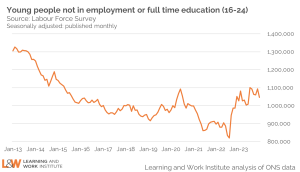
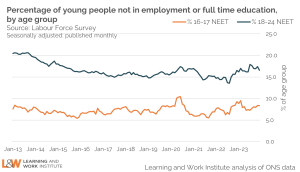
6. Vacancies are falling, but remain high relative to the level of unemployment
Headline vacancies in the November 2023 to January 2024 quarter were very similar to the previous month, at 932,000, but down by 26,000 compared with the previous quarter. The headline ONS vacancy figure is both seasonally adjusted and a three-month average. Using the official measure of unemployment, there are 1.4 unemployed people for every vacancy. However, there are an additional 1.9 million people who are economically inactive but want a job. Extending employment support to this group would potentially ease recruitment pressures for employers.
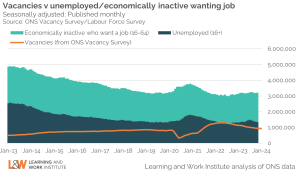
7. Numbers claiming unemployment-related benefits continue to exceed the ILO measure of unemployment
Unemployment in the October to December quarter of 2023 was 1,320,000, down by 35,000 from last month’s published level. The quarterly headline figure has fallen by 87,000 since the July to September quarter of 2023. The ONS figure for claimant unemployed is 1,579,200, up by 14,100 on last month. The number of unemployed people who are claiming unemployment-related benefits is now 245,000 higher than the number of unemployed in the official measure.
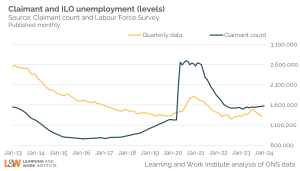
8. Unemployment rate much higher for young people than for those aged 25+
The 16- to 24-year-old unemployment rate (including students) was 11.6% of the economically active in the October to December quarter of 2023. The rate for those aged 25 to 49 was 3.2%. For those aged 50 and over it is 2.1%. The quarterly change is -0.5 percentage points for 18- to 24-year-olds, -0.1 percentage points for 25 to 49 year olds, and -0.5 percentage points for the over-50s.
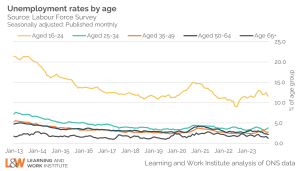
9. Long-term unemployment falling for young people
Youth long-term unemployment (which can include students) is down by 17,000 over the last quarter and stood at 132,000 in the October to December quarter of 2023. Long-term unemployment for young people is normally counted as being unemployed for six months or more. Adult long-term unemployment on the survey measure was 193,000 in the final quarter of 2023. The number of people aged 25 and over out of work for 12 months was 2,000 lower at the end of 2023 than in the previous quarter (July to September 2023).
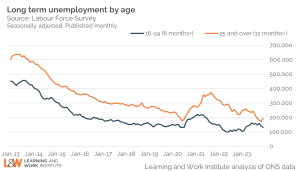
Subscribe to our newsletter to get sent our in-depth labour market analysis each month
Register for our Employment and Skills Convention 2024
